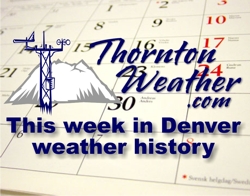
Weather is a big part of the holidays. With many people hitting the road to visit friends and family the weather can make or break those holiday plans. Our look back at this week in Denver weather history shows a number of Thanksgivings when the weather put a damper on travel plans.
19-21
In 1979…a heavy snowstorm buried most of Colorado under at least a foot of snow. Snowfall at Stapleton International Airport totaled 17.7 inches…the greatest snow depth since 1946. Winds to 60 mph produced 5-foot drifts paralyzing the city as temperatures hovered in the 20’s. While small airports closed…Stapleton remained open…but with long delays that snarled Thanksgiving holiday traffic. Schools and businesses closed and postal deliveries were delayed. Almost all major highways leading out of Denver were closed to traffic for periods of time on the 20th and 21st. Most of the snow…13.5 inches…fell on the 20th. At Stapleton International Airport…north winds gusted to 35 mph on the 20th and to 38 mph on the 21st.
20-21
In 1898…snowfall totaled 4.0 inches in downtown Denver. Northeast winds were sustained to 48 mph with gusts as high as 60 mph behind an apparent cold front on the 20th… When temperatures plunged from a high of 66 degrees to a low of 9 degrees. On the 21st the high was only 24 degrees and the low was 2 degrees.
In 1970…a wind gust to 94 mph was recorded at gold hill in the foothills west of Boulder. Strong winds also swept across metro Denver. Wind gusts reached 59 mph in downtown Boulder…while at Stapleton International Airport west- northwest winds gusted to 43 mph on the 21st. Damage was minor.
In 1992…a large Canadian air mass moved into the state at the same time an upper level storm system approached from the west. The combination of cold air at the surface and very moist air aloft produced heavy snow across the entire state. Snowfall totaled 6.3 inches at Stapleton International Airport…where north winds gusted to 23 mph on the 20th. Snow was heavier in the foothills…with 14 inches at Wondervu…13 inches at Aspen Springs…Conifer… Boulder…and Gross Reservoir…8 inches at Rollinsville… And 10 inches at Golden Gate Canyon and Morrison.
In 2007…a storm system brought moderate to heavy snowfall to portions of the urban corridor. Storm totals included: 7 inches…3 miles south-southeast of Fort Collins…with 6 inches in Boulder and at Horsetooth inlet bay. Elsewhere… Storm totals ranged from 2 to 5 inches. Snowfall totaled 2.0 inches at the site of the former Stapleton International Airport.
Continue reading November 21 to November 27 – This week in Denver weather history
